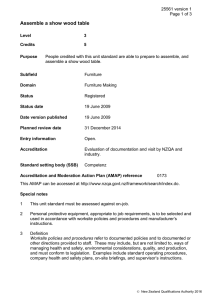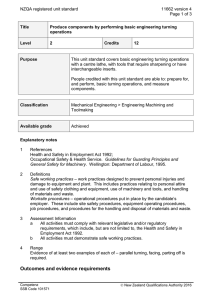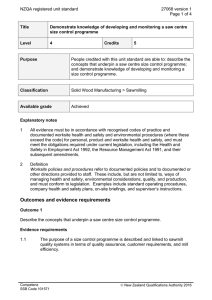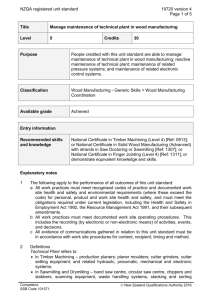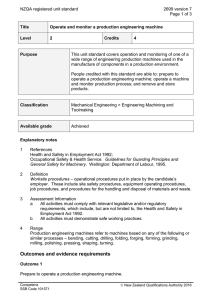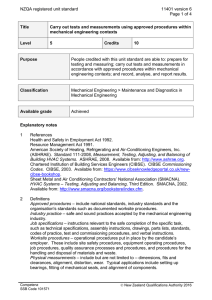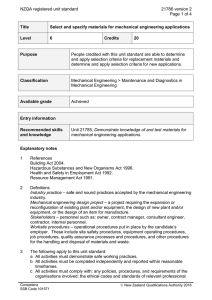NZQA registered unit standard 28156 version 1 Page 1 of 5
advertisement
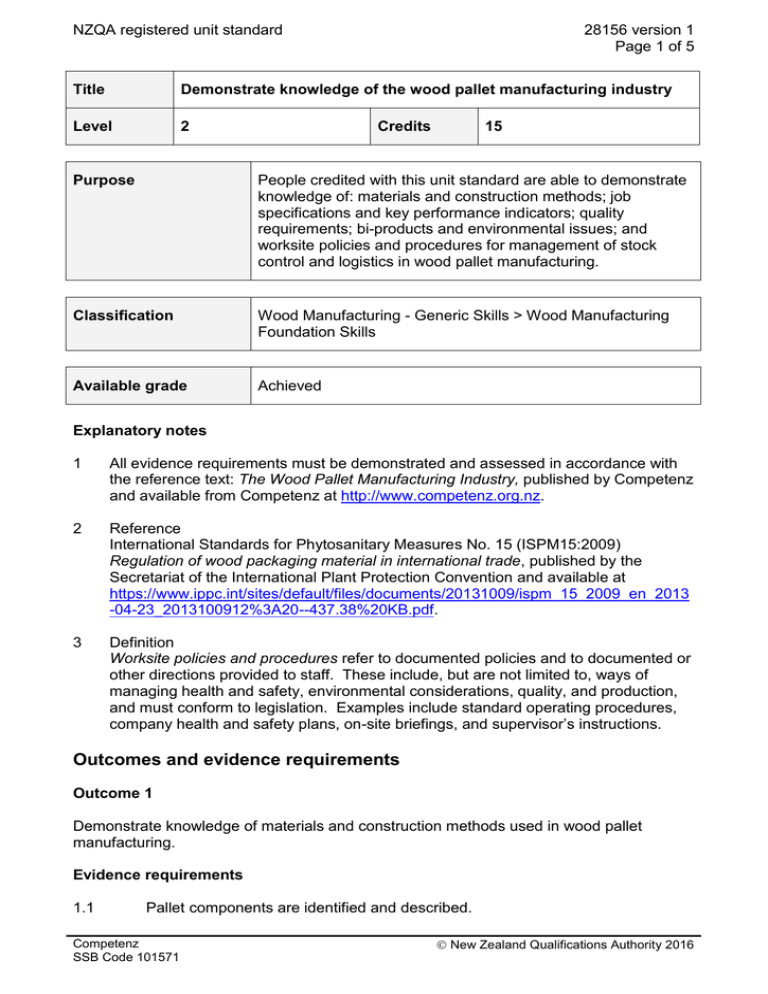
NZQA registered unit standard 28156 version 1 Page 1 of 5 Title Demonstrate knowledge of the wood pallet manufacturing industry Level 2 Credits 15 Purpose People credited with this unit standard are able to demonstrate knowledge of: materials and construction methods; job specifications and key performance indicators; quality requirements; bi-products and environmental issues; and worksite policies and procedures for management of stock control and logistics in wood pallet manufacturing. Classification Wood Manufacturing - Generic Skills > Wood Manufacturing Foundation Skills Available grade Achieved Explanatory notes 1 All evidence requirements must be demonstrated and assessed in accordance with the reference text: The Wood Pallet Manufacturing Industry, published by Competenz and available from Competenz at http://www.competenz.org.nz. 2 Reference International Standards for Phytosanitary Measures No. 15 (ISPM15:2009) Regulation of wood packaging material in international trade, published by the Secretariat of the International Plant Protection Convention and available at https://www.ippc.int/sites/default/files/documents/20131009/ispm_15_2009_en_2013 -04-23_2013100912%3A20--437.38%20KB.pdf. 3 Definition Worksite policies and procedures refer to documented policies and to documented or other directions provided to staff. These include, but are not limited to, ways of managing health and safety, environmental considerations, quality, and production, and must conform to legislation. Examples include standard operating procedures, company health and safety plans, on-site briefings, and supervisor’s instructions. Outcomes and evidence requirements Outcome 1 Demonstrate knowledge of materials and construction methods used in wood pallet manufacturing. Evidence requirements 1.1 Pallet components are identified and described. Competenz SSB Code 101571 New Zealand Qualifications Authority 2016 NZQA registered unit standard 28156 version 1 Page 2 of 5 1.2 Timber sizes used to manufacture or repair pallets are identified and described in accordance with worksite policies and procedures. 1.3 Types of nails are identified and their use is described. Range 1.4 Types of saw blades used in saw centres are described. Range 1.5 evidence of three nail types is required. evidence of three saw centres is required. The effects of saw features on cutting quality are described. Range saw features – sharpness, kerf, gullet. Outcome 2 Demonstrate knowledge of wood pallet manufacturing job specifications and key performance indicators. Evidence requirements 2.1 Job specifications are described for two products in accordance with worksite policies and procedures. 2.2 End users of products described in evidence requirement 2.1 are identified. 2.3 Methods to communicate product specifications are described and worksite examples are given. Range 2.4 Production key performance indicators (KPIs) are explained and an example of how the candidate or candidate’s team have contributed to achieving the KPIs is given. Range 2.5 methods may include but are not limited to – job cards, worksite instructions, product sheets, product specifications, customer specifications, industry specifications, national standards, international standards; evidence of at least two is required. KPIs may include but are not limited to – reduce waste, increase productivity, decrease production costs, decrease quality costs, minimise delays; evidence of at least two is required. Factors that affect KPIs are identified and linked to the indicators described in evidence requirement 2.4. Outcome 3 Demonstrate knowledge of quality requirements in wood pallet manufacturing. Competenz SSB Code 101571 New Zealand Qualifications Authority 2016 NZQA registered unit standard 28156 version 1 Page 3 of 5 Evidence requirements 3.1 Product quality requirements for internal processing steps are described in accordance with worksite policies and procedures. 3.2 Methods used to ensure quality requirements are met at each processing step are described in accordance with worksite policies and procedures. 3.3 The affects of poor quality on internal and external customers is explained. 3.4 The purpose of ISPM15 is explained. 3.5 Methods of treating wood pallet manufacturing timber are described in accordance with ISPM15. 3.6 Procedures for tracking ISPM15 branded product are described in accordance with worksite policies and procedures. Outcome 4 Demonstrate knowledge of bi-products and environmental issues related to wood pallet manufacturing. Evidence requirements 4.1 Waste residue is explained in terms of its value and use as a bi-product. 4.2 Potentially detrimental effects to the environment of wood pallet manufacturing are identified. Range 4.3 Health hazards related to wood pallet manufacturing workers are identified. Range 4.4 health hazards may include but are not limited to – treated wood, dust, noise, fumes. Types of possible contamination within the workplace are identified. Range 4.5 evidence of two effects is required. evidence of three is required. Procedures to be followed at the workplace in case of environmentally hazardous situations are explained in accordance with worksite policies and procedures. Range Competenz SSB Code 101571 procedures may include but are not limited to – personal health and safety, environmental protection, reporting. New Zealand Qualifications Authority 2016 NZQA registered unit standard 28156 version 1 Page 4 of 5 Outcome 5 Demonstrate knowledge of worksite policies and procedures for management of stock control and logistics in wood pallet manufacturing. Evidence requirements 5.1 The process flow of stock is explained in accordance with worksite policies and procedures. 5.2 Components of the supply chain within logistics are described. components may include but are not limited to – inwards goods, quarantine, storage, returns, issue, distribution and despatch, inventory control, purchasing and supply, cataloguing. Range 5.3 A selected product’s supply chain is traced from raw material to the customer. 5.4 Location and storage requirements are described for each product in accordance with worksite policies and procedures. 5.5 Equipment used to handle each type of material and/or goods is identified and described in accordance with worksite policies and procedures. equipment may include but is not limited to – conveyors, forklifts, forkhoists, wheeled loaders, pneumatic systems, overhead cranes, pumps, hoses, valves. Range Planned review date 31 December 2018 Status information and last date for assessment for superseded versions Process Version Date Last Date for Assessment Registration 1 15 January 2014 N/A Consent and Moderation Requirements (CMR) reference 0173 This CMR can be accessed at http://www.nzqa.govt.nz/framework/search/index.do. Please note Providers must be granted consent to assess against standards (accredited) by NZQA, before they can report credits from assessment against unit standards or deliver courses of study leading to that assessment. Industry Training Organisations must be granted consent to assess against standards by NZQA before they can register credits from assessment against unit standards. Providers and Industry Training Organisations, which have been granted consent and which are assessing against unit standards must engage with the moderation system that applies to those standards. Competenz SSB Code 101571 New Zealand Qualifications Authority 2016 NZQA registered unit standard 28156 version 1 Page 5 of 5 Requirements for consent to assess and an outline of the moderation system that applies to this standard are outlined in the Consent and Moderation Requirements (CMR). The CMR also includes useful information about special requirements for organisations wishing to develop education and training programmes, such as minimum qualifications for tutors and assessors, and special resource requirements. Comments on this unit standard Please contact Competenz qualifications@competenz.org.nz if you wish to suggest changes to the content of this unit standard. Competenz SSB Code 101571 New Zealand Qualifications Authority 2016
